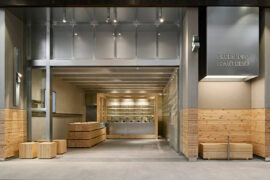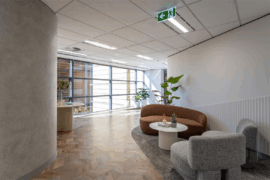The work of Shigeki Fujishiro is quintessentially Japanese, but the product designer tells Iliyas Ong it was never his intention.

October 22nd, 2013
Shigeki Fujishiro brushes off the suggestion that his designs look and feel ‘Japanese’. He never intended to subscribe to the ‘Japanese’ aesthetic, but the 39-year-old product designer admits the influence might have been unconscious. “I don’t think about the ‘Japanese style’,” he adds. “I don’t care. Maybe it’s just in my head. Some foreigners may feel I’m very Japanese, but I don’t focus on that. It comes naturally.”
Frames
Wherever his motivations and influences lie, there’s no denying the quintessential Japanese-ness of the final products. They are clean, simple and quiet, but they also bear a distinctive playfulness and quirkiness that has become the ex-IDÉE designer’s hallmark since founding the Shigeki Fujishiro Design studio eight years ago. Three of his designs—‘Frames’, ‘Knot Basket’ and ‘Eiffel’—are on exhibition in Singapore at Gallery 38 in Gillman Barracks until 15 November 2013, with ‘Frames’ and ‘Knot Basket’ up for sale.
Frames
‘Frames’, the lead product on display, is a series of 3-D mobiles that look more like contemporary art sculptures. Dangling from the ceiling by a transparent thread, ‘Frames’ appears to levitate off the ground, spinning around and casting shadows whose outlines morph and bend on the walls. It is meant as an expression of spatial relationships, Fujishiro explains, and can be considered as “nearly art”. “But this is the only thing from me that isn’t useful,” he says. “It’s hard to categorise this.”
Frames
‘Eiffel’ and ‘Knot Basket’, however, sit firmly in the field of product design. The former is a three-legged stool and the latter, a round basket that sits impossibly upright despite being made of rope. “It’s interesting because people feel that the rope cannot ‘stand up’,” Fujishiro laughs. “But if it’s a small grid and thick rope, it’s possible. It looks like a sculpture—a wire sculpture.” Not unlike the outlines of ‘Frames’.
Knot Basket
And that’s not the only thing these products have in common. All three are made with what Fujishiro calls “material from normal life”: hinoki wood in ‘Frames’, paper in ‘Eiffel’, and that thick red rope in ‘Knot Basket’. “I don’t like strong materials,” he remarks. “I prefer choosing materials we know from before. I like natural things, because they’re easy to fit together in one space.”
Eiffel
This emphasis on ‘fitting in’ is what stamps the ‘Japanese’ quality on Fujishiro’s products—it’s not unlike one of his design heroes, Naoto Fukasawa. Fujishiro recalls visiting an exhibition of Fukasawa’s works years ago, which eventually informed his own design language. “I got so much inspiration from that exhibition,” he reveals. “It made me ask, ‘What is a good ‘match’ with other things?’ The simple things are easy to get together.”
Pointing to the ‘Eiffel’ stool, Fujishiro sums up his design philosophy: “I don’t like too much design. This is very simple construction. Construction and form should be ‘one thing’. Then it becomes beautiful, because there is harmony. There are also no decorative elements. If there are strong decorations, some people would hate it.”
Photos © The Primary Studio
The exhibition is on from now till 15 November in Singapore at the Gillman Barracks, Gallery 38, #01-06 Malan Road. Hours: 11am – 8pm (closed on Mondays). Visit the Gillman Barracks website for more information.
INDESIGN is on instagram
Follow @indesignlive
A searchable and comprehensive guide for specifying leading products and their suppliers
Keep up to date with the latest and greatest from our industry BFF's!

Sydney’s newest design concept store, HOW WE LIVE, explores the overlap between home and workplace – with a Surry Hills pop-up from Friday 28th November.

Merging two hotel identities in one landmark development, Hotel Indigo and Holiday Inn Little Collins capture the spirit of Melbourne through Buchan’s narrative-driven design – elevated by GROHE’s signature craftsmanship.
The internet never sleeps! Here's the stuff you might have missed

Hecker Guthrie brings a natural, material-led design to Green Cup’s new Chadstone store, pairing pine, steel and glass with a grab-and-go layout inspired by the brand’s fresh, organic ethos.

With the opening of the 2026 INDE.Awards program, now is the time to assess your projects, ensure photography is at hand and begin your submissions.

Sydney’s newest design concept store, HOW WE LIVE, explores the overlap between home and workplace – with a Surry Hills pop-up from Friday 28th November.

A thoughtful, low-waste redesign by PMG Group in collaboration with Goodman has transformed a dated office into a calm, contemporary workspace featuring a coastal-inspired palette and Milliken flooring for a refined finish.